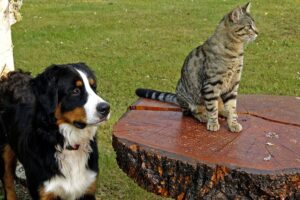Menu
How to Introduce a Puppy to a Cat
The process of how to introduce a puppy to a cat requires patience, gradual introductions, and understanding the behavior of both animals.
If you have an older cat and a very wild puppy, it can lead to a very unhappy cat. I will be addressing that further down in addition to puppy energy spurts often called the “puppy witching hour.” I’ll also talk about how to properly correct an older puppy for being disrespectful to a cat. These are no-nonsense tips from a real balanced dog trainer in Portland, Oregon.
Here are valuable tips for a smooth and peaceful transition.
Understanding the Dynamics of Introducing a Puppy to a Cat
The process of introducing a puppy to a cat demands careful planning, management, and a nuanced understanding of each animal’s natural instincts and behaviors. Most adult animals including dogs do not like puppies because they are erratic, hyper and often disrespecting of their personal space. However, in time, puppies need to learn how to respect them.

A puppy or dog should never:
- Chase a cat
- Treat it like prey
- Try to play with it like a fellow dog
Cat Meeting Puppy
When you introduce a puppy to a cat, do not just let your puppy have free access to your cat. Begin by isolating the new puppy in a separate room, allowing the cat to become accustomed to the puppy’s scent and sounds. Swapping their bedding or toys gradually familiarizes them with each other’s presence. Always keep them separated in the beginning and gradually teach your puppy rules about how to interact with the cat. Check out my other blog, “Why Are Puppies So Hyper?” for more tips.
How to Introduce a Puppy to an Old Cat
Be especially careful when you introduce a puppy to an old cat. Advocate for your senior cat by not letting the puppy have access to it. Make sure your puppy is always on a leash if they are in the same room together. Be very strict and vigilant about making sure your old cat feels safe.
Gradually Introduce Your Puppy to Your Cat
Gradually introduce them under controlled supervision. Utilize a leash for the puppy and allow the cat to roam freely. Reward positive interactions with treats and praise. Always have your puppy on a leash so they can’t run up and tackle your cat.
Puppy Witching Hour and Managing Behavior
Puppies may exhibit hyperactivity and biting tendencies, especially during the “puppy witching hour.” Puppy witching hour is when puppies get a huge burst of energy. They can be a lot more annoying to your cat during these times. Check out my blog on how to calm puppies down overall if you are struggling with puppy witching hour.
Ensure your cat has safe spaces to retreat to when the puppy gets overly excited or nippy. However, you do not want your cat chased out of the room or house because your puppy has priority. Check out my blog on the puppy board and train, which addresses crate training your puppy and containing them.
Help Your Cat to Feel Safe
Designate areas to retreat if your cat needs space. Provide high perches, cat trees or hiding spots for the cat. Use a baby gate to separate rooms so your cat doesn’t have the puppy run up to them trying to play.
If the cat senses the puppy is crated and contained at times, they will feel safer. It’s very obvious to your adult animals if you are giving your puppy free reign over the house. This includes having them out for hours and hours in the common room. This makes your other animals feel like they aren’t a priority anymore. You don’t want that. Crate train your puppy, so your cat feels safe and like there is time and space for them even though you have a new puppy. Remember puppies need about 18 – 20 hours of sleep a day. This means have them out for an hour or so then crate them.
Consistently Train your Puppy
Enroll your puppy in obedience classes or seek out a dog trainer. I am a dog trainer in Portland, Oregon and also specialize in training puppies. Training helps establish boundaries and gives you something structured to do with your puppy around your cat.
Eventually you can use your cat to help training your puppy through the “place command.” Work on “place training” as your puppy gets older (as early as 3 – 4 months old). At 3 months old you can start using the place board to practice your basic obedience with positive reinforcement. They can jump up there and do “sit, down” and “come.”
A puppy can start to hold some duration (time) on place in a “stay” around 5 – 6 months. Even 15 minutes of place, while your cat is able to walk around the older puppy is fantastic. This teaches the older puppy that they have to hold the place command even with distractions like cats. It’s very good for impulse control and respecting the cats space in addition to your rules.
Help Your Cat Adjust to Your Puppy
The best way to introduce a puppy to a cat is to allow your pets time to adjust to each other. Gradually increase the duration of their interactions as they become more comfortable with one another. Let them be around each other more and more as the puppy gets older but always have them on a leash if they’re being rude or trying to play with the cat. Do not allow that behavior. Make them be around each other but require your puppy to be polite. You can redirect them from the cat with other toys, obedience or chews.
Your cat will feel more comfortable around your puppy if you have never let your puppy harass them from the beginning!

Conclusion: How to Get a Puppy and Cat to Get Along
If tensions persist or either pet shows signs of extreme distress, consulting a dog trainer can provide tailored guidance for a successful introduction.
Successfully integrating a puppy into a household with a cat requires patience, gradual introductions, and understanding the unique needs of both animals. With consistency you can advocate for your cat and help to teach your dog how to behave around them.
Even though I am a dog trainer in Portland, Oregon, I can also do zoom consultations. Click here to schedule one.


